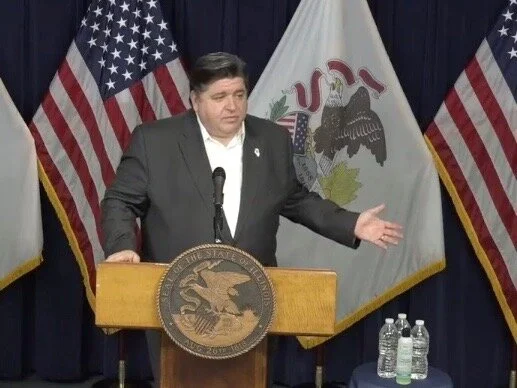J.B. to idled gig workers: File claims now
Governor says traditional claim must be denied before new relief is granted; COVID-19 deaths, cases level out
Gov. Pritzker speaks at the daily coronavirus briefing Thursday in Chicago. (Illinois.gov)
By Ted Cox
The governor urged so-called gig workers to file unemployment claims immediately in order to receive benefits when new relief funding becomes available next week.
At his daily coronavirus briefing Thursday at the Thompson Center in Chicago, Gov. Pritzker lauded employees at the Illinois Department of Employment Security, even as he granted that the agency had been “fundamentally defunded for many years” and rendered “unfit” to meet the “unprecedented” demands of the COVID-19 economic crash by a decade of staff and funding cuts. He said that “as promised” independent contractors, freelancers, the self-employed, tipped workers, and ride-share drivers would be able to apply for unemployment through a new system meant to process 140,000 claims an hour as of Monday.
But he emphasized that, according to the demands of the coronavirus relief act that opened unemployment to 1099 workers — as they’re know by the income form they file with their tax returns, rather than the W-2s filed by salaried employees — they first must be rejected under the old rules before they can receive benefits under the expanded federally funded unemployment.
On a day that saw state unemployment claims decline slightly week to week, while 3.2 million new claims were reported nationwide, Pritzker repeated the advice from an IDES news release issued earlier in the week for those idled workers to file immediately under the existing system.
Pritzker pointed out the IDES system was developed to handle the crush of unemployment claims seen during the Great Recession a decade ago, when 180,000 filed nationwide in the first nine weeks. By contrast, he added, the state had to process more than 1 million claims in the first nine weeks of the coronavirus crisis since March 1.
“In the first four months of 2020, Illinois has paid out over $2 billion in claims,” he said. “That’s $500 million more than was paid out over all 12 months of 2019.”
He praised IDES staffers, who’d seen 500 positions cut over the last decade, saying, “In many ways they’ve been forced to build a new airplane while flying it.”
He added, “These people are working night and day. Each person is doing the work of three people,” together logging thousands of hours of overtime. “We’re ramping it up as much and as fast as possible.”
In addition to the new system processing 140,000 claims an hour, there will be 100 additional agents working IDES phones by Monday, with 100 more to follow.
“The financial toll on the people of Illinois has been breathtaking,” Pritzker said. “I will not rest until we get our residents the support they need to get through this battle.”
Urgency over the unemployment claims overshadowed a day that saw Illinois top 3,000 deaths and 70,000 cases stemming from COVID-19.
“Yes, the curve has bent, but it has bent to flat,” Pritzker said.
Illinois Public Health Director Dr. Ngozi Ezike reported 2,641 new COVID-19 cases Thursday, pushing the state total to 70,873. Some 138 new deaths brought the statewide toll to 3,111. Hospitalization remained fairly level, and indeed both Ezike and Pritzker said the state appeared to have reached an extended plateau in the coronavirus outbreak.
“We’ve been fiat for some time now,” Ezike said, mainly over this first week of May, which has seen both record highs for cases and deaths reported in a day, at 3,137 last Friday and 176 on Tuesday. “So where we go next is critical.”
As the NFL prepared to release its 2020 schedule, including of course for the Chicago Bears, Pritzker expressed support, even as he was doubtful whether the games will be played in front of fans in stadiums or simply aired on TV. “I want to get sports up and going. I think people need this as an outlet,” he said. “I think it’s important to everybody’s psyche.”
But he was also dubious about water parks and theme parks like Great America opening this summer, as well as shopping malls, and he remained adamant about churches holding services.
Yet Pritzker maintained that his Restore Illinois plan — which allows for four regions of the state to make progress on easing stay-at-home restrictions if they maintain the same level of infection over a month — was to be preferred over previous White House requirements calling for areas to see a two-week drop in cases to open up. “I think that’s going to turn out that some areas of the state are going to open up earlier” under his plan, he said.
The governor expressed optimism that a successful treatment for COVID-19 could be discovered relatively soon and enable restrictions to be eased.
“I know everybody sees a vaccine as happening who knows when,” he said. “But an effective treatment is potentially on the horizon, and that will change everything.”
Until then, Ezike called on Illinoisans to resist the urge to get out more as the weather improves. “If it stays the same, that’s great, we will quickly move through the phases” to open up the economy, she said. “But we have to be realistic. The more people are out, the more infections there’ll be. The more infections there’ll be, the more hospitalizations there’ll be. The more hospitalizations, a fraction of those will go on to have complications and potentially die.”
As such she warned residents about making an exception for Mother’s Day this weekend.
“We are still fighting this invisible enemy, and we must continue to take measures to reduce its spread,” Ezike said. “Please let’s honor our elderly mothers and grandmothers this Mother’s Day by keeping them safe. To do that, please stay at home, please wear your face coverings, please wash your hands frequently.”

